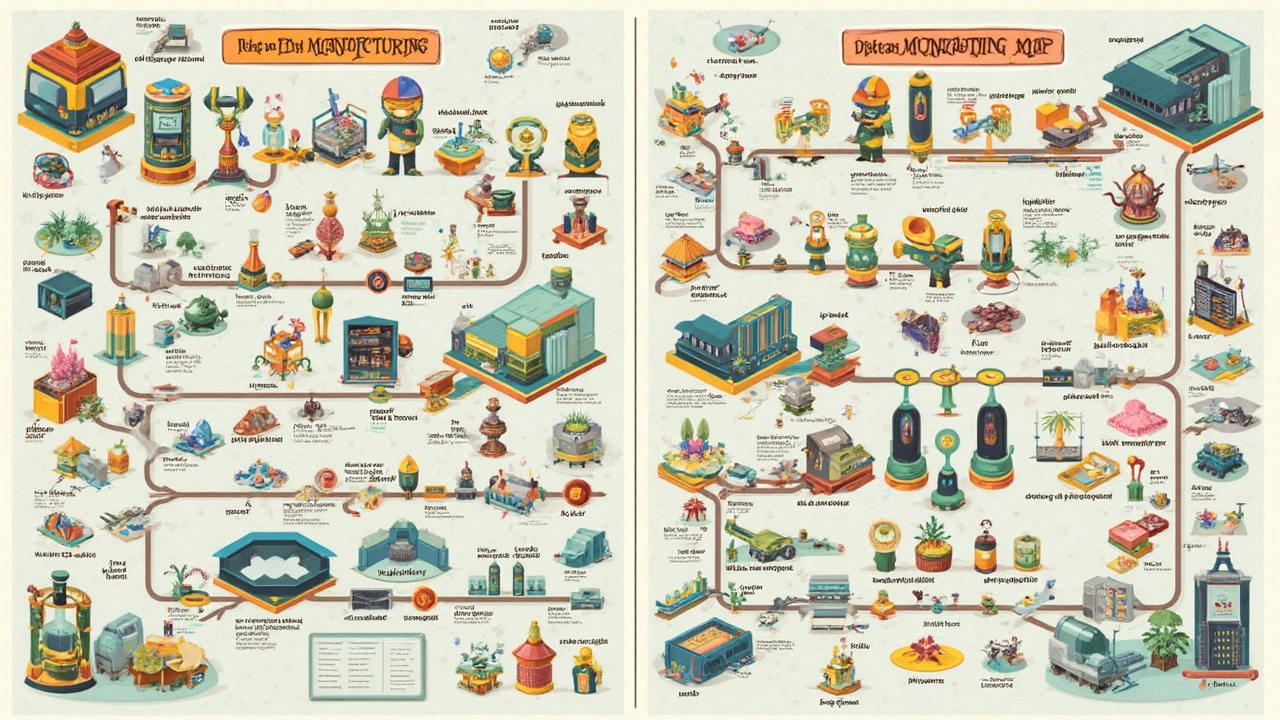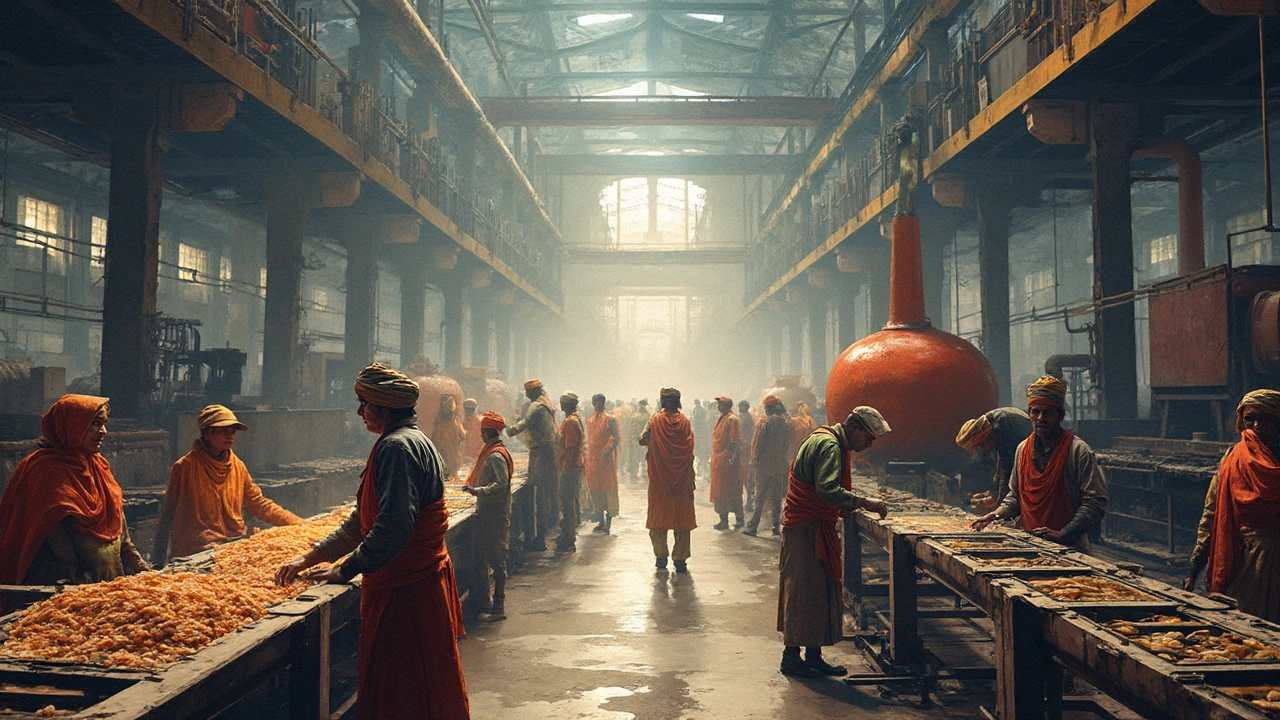Ever wondered what keeps the wheels of the manufacturing world turning? It's all about understanding the two main types of manufacturing. First up is discrete manufacturing. Think of it like building a Lego model, one piece at a time; it's all about creating distinct, individual items. Cars, furniture, electronics—these are classic outputs.
On the other hand, there's process manufacturing. This one's like baking a cake. You're mixing ingredients in bulk, and the end product can't be taken apart into its original raw materials. Foods, chemicals, and beverages fall under this category.
- Understanding Discrete Manufacturing
- The Insights into Process Manufacturing
- Government Schemes Supporting Manufacturing
- Real-World Examples and Their Applications
Understanding Discrete Manufacturing
Discrete manufacturing is like a giant puzzle, where each piece plays a crucial role in forming the final picture. It revolves around the creation and assembly of individual parts or products. We're talking about physical items that you can count, touch, and often disassemble. Everyday examples include electronic gadgets, automobiles, and home appliances. Each product is made up of numerous parts that are put together to form a finished item.
The process begins with raw materials, which are shaped and assembled through various stages. Think of it as stages on a production line where each station adds something new to the piece. Once a batch is done, the machines can be recalibrated for a new set of items, offering flexibility in production.
One of the key benefits of discrete manufacturing is its adaptability. These facilities can switch gears and produce entirely different items without a complete overhaul of the machinery. This makes businesses nimble, allowing them to respond swiftly to market changes or customer demands.
Understanding how discrete manufacturing works can really help align with government incentives and schemes aimed at boosting local production. It’s a perfect fit for sectors requiring precision and customization. Plus, it often aligns with sustainable practices since products are designed for easy disassembly and recycling.
Here's a simple comparison of the main features of discrete manufacturing:
| Feature | Discrete Manufacturing |
|---|---|
| Product Type | Individual, distinct items |
| Flexibility | High; easy to switch production lines |
| Industries | Automotive, electronics, furniture |
Overall, discrete manufacturing is all about precision, efficiency, and the ability to adapt quickly. Recognizing these traits is key to making the most of related government programs and staying ahead in a competitive market.
The Insights into Process Manufacturing
When we talk about process manufacturing, we're diving into a world that turns raw materials into huge batches of products. Imagine the transformation that turns crude oil into gasoline or milk into cheese. It's all about making things in bulk where separating end products into their original ingredients is nearly impossible.
Unlike discrete manufacturing where individual parts come together like puzzle pieces, process manufacturing is continuous. Picture massive tanks; they’re constantly processing and refining. It's widespread in industries like pharmaceuticals, food and beverage, and chemicals.
Ever heard of a continuous chemical plant running without interruption? That's process manufacturing at its best, achieving economies of scale while minimizing waste.
One cool thing about it is how automation has sharply cut down human error, making products more consistent. But don't just take my word for it—check out this hypothetical productivity chart from a decade ago when manual processes were still common:
| Year | Manual Output | Automated Output |
|---|---|---|
| 2015 | 500 units | 800 units |
| 2020 | 550 units | 1100 units |
Notice the jump? Automation not only speeds things up but also scales production significantly.
Governments often offer special schemes to boost this sector. Why? Because a strong process manufacturing industry can lead to more stable economies, especially in developing regions. Financial incentives, easier permitting, or grants for updating technology are some perks businesses can snag.

Government Schemes Supporting Manufacturing
It's no secret that governments love strong manufacturing sectors—they're like the engines driving economic growth. So they roll out schemes to support this vital part of the economy. Whether it's about expanding discrete manufacturing capabilities or boosting process manufacturing efficiency, these schemes can make a huge difference.
In the U.S., for example, there's the Advanced Manufacturing Partnership (AMP). This initiative focuses on innovating advanced manufacturing processes to sustain economic growth. Their goal? Equip manufacturing firms with cutting-edge research and tech to remain competitive globally.
India, on the other hand, has its ambitious 'Make in India' initiative. Launched to make India a global manufacturing hub, it provides incentives like tax rebates, establishing special economic zones, and simplifying of the regulatory framework to attract investments.
- The UK supports manufacturing through its 'Made Smarter' initiative, which helps integrate digital technologies into manufacturing processes.
- Germany’s 'Industry 4.0' strategy works on blending the Internet of Things with manufacturing for smarter, more efficient production.
These efforts are not just about pouring resources. They aim to push innovation, encourage job creation, and improve sustainability.
If you've got a business in manufacturing, tapping into these government schemes can be a real game changer. It can reduce costs and open up new avenues for growth.
Real-World Examples and Their Applications
Let's get down to brass tacks and see how these manufacturing types play out in real life. When you hop into a car, you're literally surrounded by discrete manufacturing. Each part, from the tires to the seat cushions, is made separately and assembled to create that smooth ride.
Take Tesla, for example, known for their innovative electric cars. They revolutionized the process not only by building cars but doing so with precision in each part of the production line. The company's success hinges on the precise assembly and quality control innate to discrete manufacturing.
Contrast that with the world of process manufacturing — think mass-produced items like Coca-Cola. The beverage giant uses process manufacturing to create millions of cans and bottles. Here, the emphasis is on consistency and efficiency, ensuring each sip tastes just like the last. This type of production relies heavily on large-scale techniques and sophisticated chemistry.
"Understanding the differences in manufacturing processes can help businesses streamline operations and improve quality control." - Tech Analyst Journal
Looking at the support structures, government schemes often offer subsidies or tax incentives to companies upgrading their technology or improving environmental standards. These programs can be a lifeline for small to medium companies trying to compete by adopting advanced manufacturing techniques.
Whether it's building cars or producing beverages, knowing which manufacturing type fits can be game-changing for businesses. In the end, it all comes down to what you're producing and how you plan to deliver it to the market.
